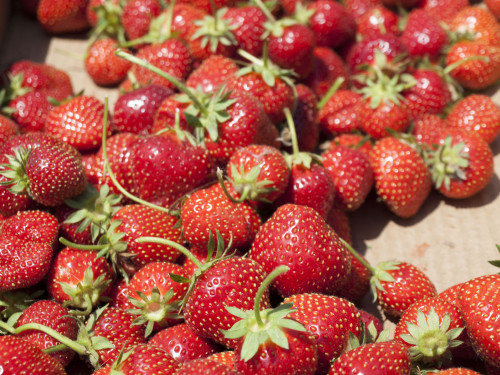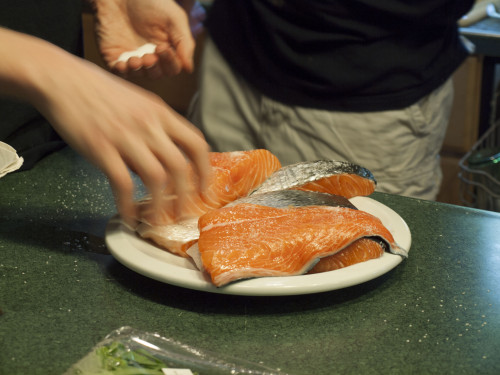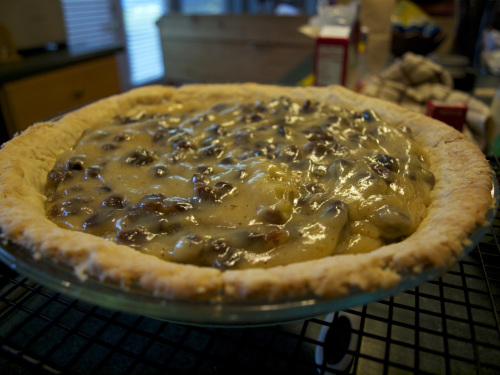 Needless
to say, supermarket strawberries and their fresh-picked counterparts
are of entirely different material: the first, a watery ectoplasm, the
second, a thick honey. In the fields, strawberries grow close to the
ground, buried under their own leaves and hay. Hence the German
word Erdbeeren, or earth-berries. Yet, strawberries taste
more celestial than chthonic; they are a blood spatter of sunlight cast
into fleshy gems. Warmed by the sun, a fresh strawberry looks
translucent and tastes like a heady breath of perfume. In St. Louis, we
pick fist-sized berries, not fragile fraises des bois. Whereas the
biggest supermarket berries often taste the weakest, the most mature
specimens on the farm contain the most concentrated flavor: size does
not signify dilution. We worked for an hour and harvested 15 pounds;
thus far, we have canned eight jars of jam, baked two pies, and churned a
few quarts of ice cream. With berries so sweet, I decided to add Greek
yogurt to the recipe, retaining a few egg yolks for richness. I love the
harsh scrape of strong yogurt against an almost cloying mouthful of
fruit. The following recipe only works with the best, freshest berries,
so be satisfied with pictures if you lack a local strawberry patch. Continue reading
Needless
to say, supermarket strawberries and their fresh-picked counterparts
are of entirely different material: the first, a watery ectoplasm, the
second, a thick honey. In the fields, strawberries grow close to the
ground, buried under their own leaves and hay. Hence the German
word Erdbeeren, or earth-berries. Yet, strawberries taste
more celestial than chthonic; they are a blood spatter of sunlight cast
into fleshy gems. Warmed by the sun, a fresh strawberry looks
translucent and tastes like a heady breath of perfume. In St. Louis, we
pick fist-sized berries, not fragile fraises des bois. Whereas the
biggest supermarket berries often taste the weakest, the most mature
specimens on the farm contain the most concentrated flavor: size does
not signify dilution. We worked for an hour and harvested 15 pounds;
thus far, we have canned eight jars of jam, baked two pies, and churned a
few quarts of ice cream. With berries so sweet, I decided to add Greek
yogurt to the recipe, retaining a few egg yolks for richness. I love the
harsh scrape of strong yogurt against an almost cloying mouthful of
fruit. The following recipe only works with the best, freshest berries,
so be satisfied with pictures if you lack a local strawberry patch. Continue reading
Monthly Archives: May 2012
Strawberry Greek Yogurt Ice Cream
Orzo Salad with Olives, Mushrooms, Raisins, and Sunflower Seeds
Despite the muggy weather and relative absence of olive groves, I like cooking with Mediterranean intent when I’m home from school. I’ll spin some Grateful Dead, decompress, and put a yellow onion on mellow simmer. Without the usual time constraints of college cooking, I can tinker with technique and ingredient proportion. For example, I enjoy working with salmon, but have struggled on previous attempts to achieve pork-cracklin-crisp skin. Thursday night, I let the cast iron pan reach truly incendiary temperatures before laying down a fillet. The skin tightened into a sheet of pure crunch. I served the salmon over an orzo salad—I mixed a stew of onion, raisins, sunflower seeds, mushrooms, and olives with the warm pasta. If cooking fish is a matter of precision, pasta salad is an issue of instinct. Be careful seasoning the salad, because its individual components already contain salt. I thought about adding anchovies or anchovy paste, too, but alas, the cupboard was lacking any little fishes. No lies: I have no emotional connection or special interest in the following recipe. It just tastes good, which ought to be argument enough. Continue reading
Filed under College Life, Columbia University, Recipes, St. Louis
Pics or it Didn’t Happen: Sour Cream and Raisin Pie
Zach Bell, Yale University
Back in December 2010, I baked a raisin pie and commented on its usage as a “funeral pie.” Upon some further research into a variation, the sour cream and raisin pie, I found that it also originated among Mennonites settling in the Great Plains, quickly spreading to other local communities. Funerals in the mid to late nineteenth century were opportunities for the community to gather and express hospitality. This hospitality often arrived as edibles, and especially as dessert. Guests and relatives would bring food to show their sympathy and condolences. A funeral staple was the raisin pie (and other improvised variations) , a dessert that could be quickly made out of readily available ingredients.
Filed under Food, Pics or it Didn't Happen, pie, Recipes, Zach B.
Recollecting Little Italy: Parm and Hip Red Sauce
Little Italy has not been a good place to eat, at least in recent memory. The encroachment of Chinatown on Italian territory, rising rents, dying families, and changing immigration patterns set an expiration date on the neighborhood. As classic restaurants closed up shop, only the most vulgar and bawdy tourist destinations survived. Those palaces of forgetfulness prostituted themselves to the lowest bidders—cheap spaghetti in canned red sauce? Louche lasagna, too sweet with cottage cheese? Floozy pasta e fagioli? All for sale on Mulberry Street. Although many tourist traps maintained a pretense of earnestness until the end of red sauce seemed inevitable, the best restaurants, the dim leather salons and family kitchens where regular customers kept the food honest, disappeared long before the neighborhood’s current decline. Today, however, hipster aesthetics have inflected mainstream consumer preferences. It’s hip to be square. So red sauce is back, baby, in all its kitschy glory. For be not mistaken, hipster isn’t campy. The aestheticization of lower middle class custom and culture does not transform life into style. Ordinary experience fails to and perhaps cannot achieve transcendental aesthetic value. Instead, the supposed disclosure of aesthetic value in ordinariness is a patronizing power play, an attempt to appropriate, rehearse, and eventually perform class difference as social fetish. Hipster red sauce cooking, alias Torrisi Italian Specialties, is the latest incarnation of an old school bourgeois impulse: “slumming it.” Continue reading
99 Problems and “The Voice” Is One
On the live finale of The Voice, Tony Lucca performed “99 Problems,” a rap track off Jay-Z’s The Black Album. During the judge comments, Christina Aguilera launched a blunt assault against Lucca. “The lyrical connotation was a little derogatory towards women,” Aguilera said, clearly upset at Lucca and his coach, Adam Levine. Aguilera took issue with the song’s central verse, “If you’re having girl problems I feel bad for you son / I’ve got 99 problems but a bitch ain’t one.” Lucca chose not to say the word “bitch” throughout his performance. Instead, he muffled his mouth and let out a percussive burst that, while sonically similar to “bitch,” managed to squeak past the censors. Given a chance to respond to Aguilera, Levine explained, “the ‘mmm ain’t one’ is life getting at you, things bringing you down. We’re not referring to women, we’re referring to everything.” “If you’re having girl problems,” Christina interjected, to which Adam said, “It’s called a metaphor.” While I believe that Lucca’s performance was problematic, I think Aguilera was wide of the target.
Generic brand white bread feminism—feminism as ideology—asks all the wrong questions. Such overly simplistic formulations of feminist thought criticize “99 Problems” as degrading towards women. Indeed, it is hard to deny that “99 Problems”—and much of the so-called “gangster rap” tradition—is misogynistic. The vocabulary of gangster rap is rooted in violence against women. It is just not that interesting or persuasive to denigrate “99 Problems” on the basis of its rhetoric. A more nuanced feminism might ask, “why is patriarchy so structurally entrenched in ganster rap? Why is gangster rap a discourse of sexual violence?” That is to say, I would encourage a more generous approach to “99 Problems,” one that does not hold the song to a particular ethical standard. A more productive and instructive method is to think about the song in its material, social, and historical contexts. “99 Problems” even speaks to criticisms like Aguilera’s: “Rap critics that say he’s ‘Money, Cash, Hoes’ / I’m from the hood stupid, what type of facts are those?” Like most of The Black Album, “99 Problems” looks back on life “in the hood.” In effect, the song comments on the ‘90s gangster rap tradition retrospectively. Jay-Z describes an incident in which a police officer pulls over a young black man for no reason and insists on searching the car. Although the song questions the legitimacy of police authority, the gangster rap music industry comes under fire, too. In a verse like, “Fiends on the floor, scratchin’ again / Paparazzis with they cameras, snappin’ them / D.A. try to give a nigga shaft again / Half a mill’ for bail ‘cause I’m African,” an image of rap stardom converges with the consequences of hood life. Criminal activity, gangster rap, and a police state are mutually implicated and inseparable. Therefore, “99 Problems” actually demonstrates how policing informs the culture, mores, and discourses of “the hood.” Violent language against women evolves from the complex distribution of power across police, cultural, and criminal authority. The status of “the hood” as a marginalized and exceptional space, a territory where the projection of police force is coded as white, where police politics slip into old racialized sexual politics—“the white man castrating the black man/black sexual threat” trope—explains the intersection of misogynistic discourse and “the hood’s” cultural product. Gangster rap, marked as subversive and anti-police but contained within capitalist and corporate logic, reproduces police violence as a fantasy of violence against women. What happens on the street is rehearsed in domestic spaces. The tension between the content of gangster rap and its material reality—its appropriation and consumption by white audiences—spills over into the objectification of women. Thus, I don’t find ethical criticisms of “99 Problems” persuasive in the least—the generic feminist criticism covers up for its policemen. I might go so far as to suggest that this generic feminism that cries “respect women” ventriloquizes the anxiety of white males. “Respect women” slides into “respect white women” all too easily.
My interest in discrediting the generic feminist criticism does not let Lucca off the hook. Muffling the word “bitch” castrates the original. The Lucca version cuts out the song’s profane power, transforming it into another fantasy of whiteness. By covering “99 Problems” as a country number, Lucca and Levine ripped the song out of its material, social, and historical contexts. Lucca skipped all of the lyrics specific to life “in the hood,” and so completely decontextualized “99 Problems.” Frankly, the performance came across as comical. I especially enjoyed watching the band member playing a washboard with “more life” written across the top. Lucca’s “whitening” of “99 Problems” derives from the same basic impulse as Aguilera’s generic feminist criticism. Aguilera and Levine, though in open and hostile disagreement, speak from the same ideology of racialized politics.
Filed under Music, Television, Theory and Criticism
Ommegang Abbey Ale
In Cooperstown, if you’re not drinking ballpark beer, you’re not drinking right. Starting at the Baseball Hall of Fame, walk down Main Street: hipster hasn’t touched here. Insurance salesmen waddle around stuffed into Derek Jeter jerseys; little leaguers follow, their uniforms comparatively loose on pre-adolescent frames. July slips away in cheap ice creams—scooped into mini batting helmets, pick a team—and Coors, bottles, cold. When I last visited Cooperstown, I was in-between mint chip and Miller, so I had never heard of Ommegang Brewery before last Friday. Apparently, Ommegang is located in Cooperstown, excuse my ignorance. According to Ommegang’s website, Cooperstown was the headquarters of American hop production circa the 19th century. Ommegang started in 1997 and safely predates the 21st century explosion of craft breweries and foodie beer nerds. Continue reading
Filed under College Life, Columbia University, Drinks, New York City, Travel



